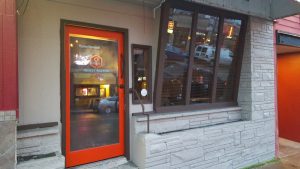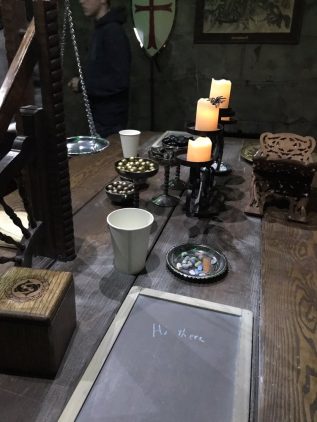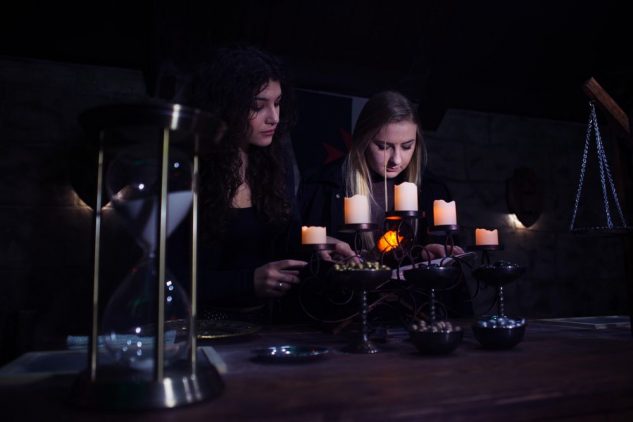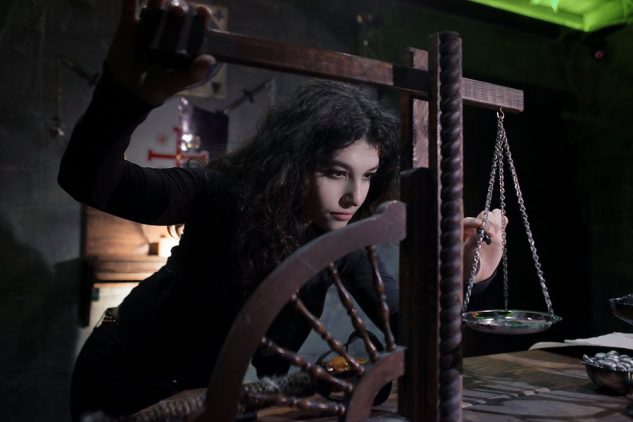It suddenly occurred to me that I haven’t reviewed an escape room from my hometown of Seattle, WA…time to fix that!

About Quest Factor (formerly known as Conundrum Quest)
Location: University District, Seattle, WA
Themes: 4
Players: 2-8, some rooms accommodate as many as 12
Duration: 60 minutes
Cost: $28 for public games, $31 for private games. At the time of this writing, there was a Groupon available.
Website: https://questfactor.us/
Escape rooms are a relatively new form of entertainment in Seattle, WA. Most of them have popped up within the last several years, Quest Factor among them. You’ll find their bright red door located along the main drag of noodle cafes and coffee shops along University Avenue.

You’ll likely meet George, a Disney software engineer who wanted to create his own versions of escape rooms he played in Russia and Vancouver, B.C. He described Quest Factor as “my own private amusement park” with Disney-inspired touches that would be a fun, rewarding puzzle experience for puzzle-solvers of all types.
Our group of friends played the “entry-level” room called the Da Vinci (rated 3 locks out 5 in terms of difficulty). The premise is something like this:
Following the trail of clues scattered throughout history, your amateur group of historians and cryptologists have finally located the hidden workshop of the one and only Leonardo Da Vinci.
You’re after the Book of Leaves that Da Vinci – mathematician, artist, inventor, engineer, and Grand Master of a secret society, Priory of Scion – possessed and hid within his secret chamber. The artifact is said to hold the power to change history and knowledge of the universe.
Are you ready to embark on an epic adventure to unravel the Da Vinci code and find the most powerful artifact in history?

As a fan of art history, I really excited about playing in this escape room. This was also one of those rare occasions when Ben and I were not playing by ourselves but in a group of 5 friends.
It became quickly apparent that this was a nonlinear puzzle-solving experience, so we were able to spread ourselves out and solve puzzles by ourselves or in pairs. We could solve the puzzles in any order.
What really stands out in my memory about the Da Vinci room were its high quality props and set pieces.
Beams of colored light streamed through stained glass windows, highlighting a beautifully carved wood trunk in the middle of the room. Dark corners and cobwebs were illuminated by a warm, simulated candlelight. Mysterious, magical music played in the background, setting a relaxed, evenly paced tone for solving puzzles.

Neat little props were scattered throughout the room – compasses, bottles, chess pieces, preserved inspects, piles of ancient books, and paintings. There were times during the game when I would look up at the stone arch above my head and wonder if it was real. The revealing of the second room was spectacularly magical, worthy of a Disney attraction.
As I mentioned in my previous review of iExit’s Pirates, sometimes props can be misleading. In Da Vinci, I felt like this was not the case. Whenever we found an object of interest, we communicated it to the rest of the group and brought objects to the center of the room where they could be investigated by anyone. There were visual and audio cues in the room that indicated what needed to be solved, including a magical sound effect to signal that we had solved a puzzle.

Regarding the puzzles themselves, I felt there was a good variety of logic, dexterity, even artistic puzzles. One of my favorites was an over-sized dexterity puzzle involving metal balls and a wine rack – I could not imagine finding that puzzle in any other setting but this one. Even the few combination locks we found made sense with the character and theming of Leonardo Da Vinci.
As far as the difficulty level is concerned, I felt that it wasn’t too difficult for novice puzzle solvers. There were a couple of people in our group who had played escape rooms only once. Everything we needed to know was inside the room – we found books to help solve art history puzzles and compasses to guide us through maps.
If worst came to worst, there was a touchscreen tablet on the wall with complete answers to the puzzles. This is a very unusual feature of most escape rooms and would probably shock hard-core puzzle solvers. Most escape rooms I’ve encountered impose a limit on the number of hints or detract from a performance score for asking too many times. At Quest Factor, there is no such scoring system, because they’re focused on players making it through the adventure.

The lack of an outside narrator/game master does raise an interesting question for the player experience.
In the past, I’ve complained about the interference of game masters who hinder the player or disrupt the immersion of the experience.
I find that Quest Factor handles this potential problem by simply replacing the role of a game master with a hints tablet. It is entirely up to the players to create their own experience. It’s up to them if they want to work out the puzzles themselves and use whatever resources are available in the room. The tablet is a “flawless” game master that serves as an extra resource in case players are really stumped and don’t know where else to search.
With the presence of a “flawless” game master, player momentum and a sense of immersion is maintained, but it is also potentially a missed opportunity for Quest Factor to create a “true” storied experience for its players.
As for our adventure, we tore the room apart in 39 minutes. Given the difficulty level of the room, five people may be overkill for this room. Nevertheless, a win is a win, and I can definitely say that the Da Vinci room at Quest Factor lived up to what their founder had set out to do: creating a fun, rewarding experience for puzzle-solvers of all types.
Final Thoughts
Final Thoughts
STORY IMMERSION 4/5
- The set pieces, props, and sound effects do most of the work to create a storied, immersive experience inside the Da Vinci room.
- The set pieces, props, and sound effects support the theming around Leonardo Da Vinci and his many talents.
- The absence of a human game master supports player momentum and sense of immersion, although it is also a missed opportunity for a “true” storied experience.
PLAYER EXPERIENCE 5/5
- Da Vinci was a man of many talents, which were shown in a variety of logic, dexterity, and artistic puzzles. There is a little bit of something for everyone, which is rewarding for a group of people who may have talents for solving specific types of puzzles.
- The technical performance of the puzzles and set pieces created a positive player experience.
- There were several stand-out puzzles that made the experience fun.
- There were “magical” touches in the room’s soundtrack and effects.
- The hints system in the form of a touchscreen was “flawless” and efficient in the strictly technical sense, because it removed human miscommunication.
TECHNICAL PERFORMANCE 4.5/5
- Digital triggers reacted appropriately to the players’ actions.
- Mechanically, the puzzles were nearly flawless. I was stuck on only 1 combination lock puzzle that needed a little extra love.
- None of the puzzles required heavy lifting or extra physical effort.
- Unfortunately, this escape room is not wheelchair accessible.
-
stars

